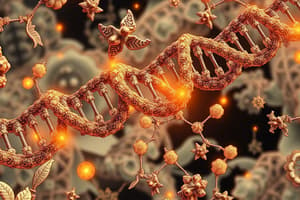Podcast
Questions and Answers
Describe the structure of a nucleotide.
Describe the structure of a nucleotide.
The nucleotide is the repeating structural unit of both DNA and RNA. A nucleotide has three components: at least one phosphate group, a pentose sugar, and a nitrogenous base.
Compare the structure of nucleotides found in DNA versus RNA.
Compare the structure of nucleotides found in DNA versus RNA.
Nucleotides vary in the sugar and nitrogenous base. DNA contains deoxyribose and the bases adenine, thymine, cytosine, and guanine. RNA contains ribose and the bases adenine, uracil, cytosine, and guanine.
What are the building blocks of a nucleotide?
What are the building blocks of a nucleotide?
A sugar (ribose or deoxyribose), a nitrogenous base, and a phosphate group.
What are purines?
What are purines?
What are pyrimidines?
What are pyrimidines?
What chemical group is found at the 3' end of a DNA strand?
What chemical group is found at the 3' end of a DNA strand?
What chemical group is found at the 5' end of a DNA strand?
What chemical group is found at the 5' end of a DNA strand?
Which of the following could be the components of a single nucleotide found in DNA? (Select all that apply)
Which of the following could be the components of a single nucleotide found in DNA? (Select all that apply)
A key difference between the nucleotides found in DNA versus RNA is that:
A key difference between the nucleotides found in DNA versus RNA is that:
Uracil is associated with DNA nucleotides.
Uracil is associated with DNA nucleotides.
Chemically, how does ribose differ from deoxyribose?
Chemically, how does ribose differ from deoxyribose?
In a nucleotide, what functional groups are attached to the 5' carbon and the 3' carbon?
In a nucleotide, what functional groups are attached to the 5' carbon and the 3' carbon?
What does 1', 2', 3', etc. mean with respect to ribose and deoxyribose?
What does 1', 2', 3', etc. mean with respect to ribose and deoxyribose?
Distinguish between AMP, ADP, and ATP.
Distinguish between AMP, ADP, and ATP.
Flashcards are hidden until you start studying
Study Notes
Nucleotide Structure
- Nucleotides are the basic building blocks of DNA and RNA.
- Each nucleotide consists of three components: a phosphate group, a pentose sugar, and a nitrogenous base.
Differences in Nucleotide Structure Between DNA and RNA
- DNA nucleotides contain deoxyribose sugar, whereas RNA nucleotides contain ribose sugar.
- Four bases are involved:
- DNA includes adenine (A), guanine (G), cytosine (C), and thymine (T).
- RNA includes adenine (A), guanine (G), cytosine (C), and uracil (U).
- Purines (A, G) have a double-ring structure; pyrimidines (T, C, U) have a single-ring structure.
Nucleotide Composition and Properties
- A nucleotide consists of:
- A phosphate attached to the 5' carbon of the sugar, forming a phosphodiester bond.
- A nitrogenous base attached to the 1' carbon.
- An important hydroxyl (-OH) group at the 3' carbon allows for linkage with adjacent nucleotides.
Types of Bases
- Purines: Include adenine (A) and guanine (G); characterized by double-ring structures.
- Pyrimidines: Include thymine (T), cytosine (C), and uracil (U); characterized by single-ring structures.
Nucleosides and Nucleotide Derivatives
- Nucleosides consist of a sugar and a base, without a phosphate.
- AMP (adenosine monophosphate) has one phosphate group.
- ADP (adenosine diphosphate) has two phosphate groups.
- ATP (adenosine triphosphate) has three phosphate groups.
Sugar Structure
- Deoxyribose has a hydrogen atom (-H) at the 2' carbon, while ribose has a hydroxyl group (-OH) at the 2' carbon.
Covalent Linkages in Nucleic Acids
- Nucleotides link together by covalent bonds formed between the 5' phosphate of one and the 3' hydroxyl of another, resulting in a sugar-phosphate backbone.
Nucleotide Differences and Functions
- The chemical structure changes between DNA and RNA affect stability: DNA is stable due to deoxyribose, while RNA is more reactive because of ribose.
- Functional groups:
- 5' carbon has a phosphate group.
- 3' carbon has a hydroxyl (-OH) group.
Cellular Components
- The difference between AMP, ADP, and ATP lies in the number of phosphate groups attached (mono-, di-, and triphosphate, respectively).
Functional Importance
- The structure and functional groups of nucleotides play critical roles in their function during processes like DNA replication and RNA transcription.
Studying That Suits You
Use AI to generate personalized quizzes and flashcards to suit your learning preferences.


